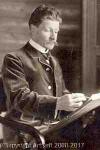Mikhail Vrubel
Mikhail Vrubel
Style: Symbolism; Art Nouveau; Byzantine Art; Realism;
Place: Omsk
Born: 1856
Death: 1910
Biography:
Early Life and Education
Mikhail Aleksandrovich Vrubel, a renowned Russian painter, was born on March 17, 1856, in Omsk, Russia. His family's noble heritage and his father's military career influenced Vrubel's early life. Despite graduating from the Faculty of Law at St Petersburg University in 1880, Vrubel's true passion lay in art. He entered the Imperial Academy of Arts, studying under Pavel Chistyakov, where he exhibited exceptional talent for drawing and an idiosyncratic style.
Artistic Career
Vrubel's artistic journey was marked by his unique blend of Symbolism and Art Nouveau. In 1884, he was commissioned to recreate the lost 12th-century murals and mosaics in the St. Cyril's Church of Kiev. This project led him to study medieval Christian art in Venice, resulting in a palette of strong, saturated tones reminiscent of precious stones.
- Seated Demon (1890), a large painting that brought Vrubel notoriety, was praised by art patron Savva Mamontov as "fascinating symphonies of a genius."
- His work on the hotel "Metropol" in Moscow, particularly the mosaic panel Princess of Dream, showcased his mastery of applied arts.
- Vrubel's interest in Oriental arts and Persian carpets influenced his texture imitations in paintings like The Demon Downcast (1901).
Notable Works and Collaborations
* Mikhail Vrubel's collaboration with opera singer Nadezhda Zabela led to his design of stage sets and costumes for her performances in Mamontov's private opera theatre. * His acclaimed pieces, such as Pan (1899), The Swan Princess (1900), and Lilacs (1900), showcased his talent for Russian fairy tales.
Legacy and Later Life
Vrubel's mental illness, complicated by tertiary syphilis, led to a severe nervous breakdown in 1906. He ceased painting and eventually passed away on April 14, 1910. Despite his untimely end, Vrubel's contributions to Russian Symbolism and Art Nouveau remain unparalleled. Explore more of Mikhail Vrubel's works on Wikioo.org: * Mikhail Vrubel | 204 Artworks * The Socialist Realism Art Movement (for context on the broader art movement in Russia) * Alfred Roller (another artist who, like Vrubel, was part of the Vienna Secession)
Wikipedia link: Click Here














